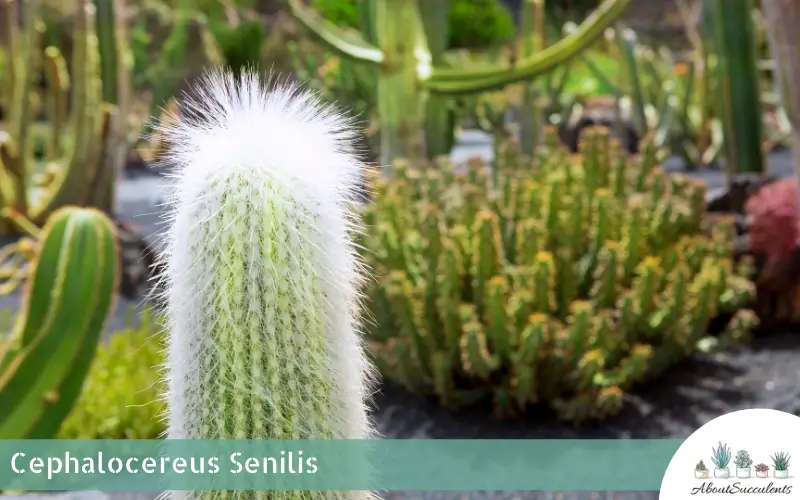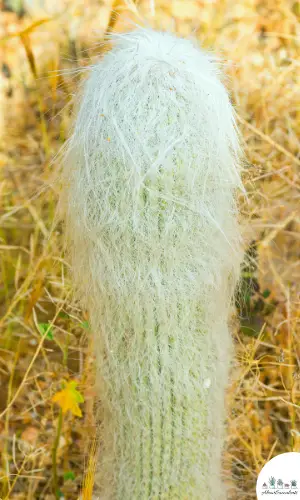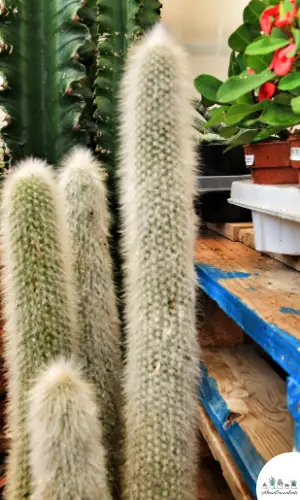
Cephalocereus senilis is a columnar succulent with a thick and fleshy body that is coated by long, silky white hairs that give it an appearance of an unkempt old man. Hence, Cephalocereus Senilis is also called “Old Man Cactus”. Other names given to Cephalocereus senilis are “White Persian Cat” and “Old Man of Mexico” because the plant is native to Mexico.
The white hairs are actually the radial spines that serve to protect Old Man Cactus from frost and the heat of the sun. The radial spines may appear soft but they conceal the sharp and dangerous central spines of the succulent.
Grown outdoors, Cephalocereus senilis can reach a height of 50-ft or 15m tall and 18-inches or 46cm wide. As a potted plant, Old Man Cactus will only grow up to 12-inches or 30cm. The Cephalocereus senilis succulent belongs to the Cactaceae family.
General Information:
Also known as: Old Man Cactus, Old Man From Mexico, White Persian Cat
Plant Family: Cactaceae
Origin: Mexico
Height: 12-inches or 30cm (indoor), 50-ft or 15m tall (outdoor)
Exposure: Exposure to sunlight for 6 hours
Water Needs: Frequent watering during summer months; very little watering in the winter or cold season.
Soil Type: Cactus soil or a combination of topsoil, perlite, and pumice.
Soil pH: Acidic (5.0 to 5.5 pH)
Maintenance Requirements: Low
Tolerance: Drought; poor tolerance to frost, heat, and salt.
How to Grow and Care for Cephalocereus senilis / Old Man Cactus

Cephalocereus senilis is a slow-growing indoor plant. It is recommended to place the succulent near a western or southern-facing window where the plant can receive more sunlight.
The ideal temperature for growing Cephalocereus senilis indoors is 18 to 29°C (65-85°F). In the winter season, OId Man Cactus should be moved to a room where the temperature is 16°C (61°F) but always above 5°C (41°F).
Sunlight
Cephalocereus senilis needs 6 hours of sunlight to produce more of its long, silky white hair. The more intense the sunlight, the thicker the hair as it functions to protect the plant from the heat of the sun’s rays.
Watering
The Cephalocereus senilis needs more water than the typical succulent. The soak and dry method where you water the plant when the soil is dry to the touch can be used for Old Man Cactus. A better approach would be to water the succulent once the top centimeter or 0.4-inch of the soil has dried out.
In the winter season, Cephalocereus senilis will not require frequent watering. With lower temperatures, the soil will stay moist longer.
Pot and Soil
Cephalocereus senilis is usually grown in a pot that measures 3-inches (8cm) until the plant becomes 4-inches (10cm) tall. Check the height of the succulent every spring and see if the roots are filling out the pot. If so, transfer Old Man Cactus to a pot that is one size larger.
It is recommended to use an unglazed pot to plant Cephalocereus senilis. Unglazed pots are more porous than glazed clay pots and allow for better air circulation around the roots.
Cactus soil or a combination of topsoil, perlite, and pumice is ideal to grow Cephalocereus senilis indoors. It is important to be sure that the soil variety is fast draining. Adding lime chips will ensure proper removal of excess moisture from the soil.
As the succulent begins to grow, stir in slow-release fertilizer into the soil. Do not apply fertilizer on the hairs of the plant.
How to Propagate Cephalocereus Senilis

The Cephalocereus senilis succulent is best propagated from seed. Although it can be grown from cuttings, it can be quite tricky. If you want to propagate Cephalocereus senilis using the cutting method, the stems should be removed when the plant is very young.
Growing Cephalocereus senilis will require patience and dedication as it will take a long time. The germination period for Cephalocereus senilis alone will take 3 months.
Propagating Old Man Cactus can be a fun activity for children who can participate and approach it like a science experiment.
Seed Method
Step 1: Fill an unglazed pot with cactus soil or a mix of perlite, pumice, and topsoil.
Step 2: Place the seeds evenly on the surface of the soil then lightly mist them using a spray bottle.
Step 3: Cover the soil with a loosely-placed plastic wrap to help maintain moisture.
Step 4: Transfer the pot to an area where it can receive plenty of indirect sunlight.
Step 5: Mist the soil as often as needed to keep it moist.
Cuttings Method
Step 1: Place the stem cuttings in a dry area where it can develop calluses.
Step 2: Set aside a pot without soil and fill it with pumice and perlite.
Step 3: Insert the cut end of the stem with the callus into the pumice and perlite mixture.
Step 4: Transfer the pot into a location where it can receive moderate sunlight. The ideal temperature would be 21°C (70°F) to grow the succulent using stem cuttings method and get the best results.
Frequently Asked Questions
Is Cephalocereus Senilis Toxic for Cats and Dogs?
The website of the American Society for the Prevention of Cruelty to Animals (ASPCA) has declared Cephalocereus as safe and non-toxic for cats and dogs.
Why is my Cephalocereus Senilis Dying?
There are 3 probable factors that may contribute to the death of your Cephalocereus senilis: Overwatering, pest infestation, and fungal infection.
Read about these factors in the sections below.
Overwatering
As a member of the Cactus family, Cephalocereus senilis can tolerate extreme heat temperatures but will require a bit more water than most varieties of succulents. Giving it too much water, especially in the cold months, will cause its roots to rot.
2. Pest Infestation
The silky white hairs of Cephalocereus senilis may protect it from the threats posed by extreme weather conditions but they are also used as a hiding place by mealybugs and spider mites. Use a mild insecticide to get rid of these pests.
3. Fungal Infection
Overwatering and excessive use of fertilizer can lead to Old Man Cactus developing a type of fungal infection called phytophthora. The signs that point to this condition include sudden wilting and the plant acquiring green discoloration.
You can reduce the risk of Cephalocereus senilis developing infection by ensuring good drainage and following a tightly-controlled schedule for fertilization.
Does Cephalocereus Senilis Produce Flowers?
Cephalocereus senilis produces flowers in the summer but only after 10 to 20 years. The flowers come from its cephalium which does not develop until the plant reaches maturity.
This succulent’s whitish-yellow flowers measure 3-inches (8cm) long with a diameter of 2.75-inches (7cm) and are shaped like a trumpet. When in full bloom during the summer season, the flowers will be accompanied by fruits that are pinkish-red in color with yellowish hair and measure 0.8 to 1-inch (2-3cm) long.
Last Updated on June 10, 2022 by Sofia Lara